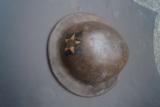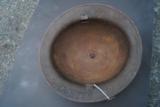 |
 |
 |

World War One US Army Doughboy Helmet 2nd Division Painted
Guns International #: 101134444 Seller's Inventory #:
Category: Military Collectible US - Military Collectible Non US
Seller's Information
When emailing or calling sellers direct, please mention that you saw their listing on GunsInternational.com
Seller: Brent Wilburn
Company: Antique Arms, Inc.
Member Since: 11/19/15
First Name: Brent
Last Name: Wilburn
State: Georgia
Zip: 30052
Country: United States
Phone: (678) 471-1432
Phone2: (678) 471-1432
Premium Seller
Number of Active Listings: 36
Total Number of Listings: 580
Seller: Private Seller
Return Policy: 3 day inspection and return policy on used guns.
Payment Types Accepted: Money Order, Certified Check
Description:
World War One American Doughboy 2nd Division Steel Helmet. This is one of the few divisions in history that was made up of US Army and US Marines. 1917-1918. Combat Engineering symbol is behind the Star with the Native American Chief. Very Good Condition with Original Paint with no liner or strap which is common. Inside the list is painted "CUSTER" in black. Nicely done. Given the last name, the Division, and that this soldier was in an engineering capacity, it's possible he could be identified. According to Wiki, the 2nd Division had the 2nd Engineering Regiment assigned to it and that appears to be the only one serving that function. I got this helmet from a collector who is a Vietnam Vet, wounded in combat, and he really knows his stuff. I set up next to him at a couple of shows each year and he is a wealth of knowledge. I bought 4 helmets from him several years ago, this being one of them. He bought a lot of great division marked helmets back when they were easier to find. Over the year's, I've had helmets from the 81st, 91st, Statue of Liberty Division, Rainbow Division, 5th Division, Motor Transport, and even one with remnants of a propellor sympbol from the US Army Aviators. This is the maybe one of two 2nd Divisions I've ever had. They don't come up for sale as often as everybody loves the War Chief not to mention the history behind it. These are still very affordable today. Great helmet from a historic Division that fought several major tough battles in the Great War. History:
World War I
The 2nd Division was first constituted on 21 September 1917 in the Regular Army. It was organized on 26 October 1917 at Bourmont, Haute Marne, France.
Order of battle
- Headquarters, 2nd Division
- 3rd Infantry Brigade
- 9th Infantry Regiment
- 23rd Infantry Regiment
- 5th Machine Gun Battalion
- 4th Marine Brigade
- 5th Marine Regiment
- 6th Marine Regiment
- 6th Machine Gun Battalion
- 2nd Field Artillery Brigade
- 12th Field Artillery Regiment (75 mm)
- 15th Field Artillery Regiment (75 mm)
- 17th Field Artillery Regiment (155 mm)
- 2nd Trench Mortar Battery
- 4th Machine Gun Battalion
- 2nd Engineer Regiment
- 1st Field Signal Battalion
- Headquarters Troop, 2nd Division
- 2nd Train Headquarters and Military Police
- 2nd Ammunition Train
- 2nd Supply Train
- 2nd Engineer Train
- 2nd Sanitary Train
- 1st, 15th, 16th, and 23rd Ambulance Companies and Field Hospitals
The division spent the winter of 1917–18 training with French and Scottish veterans. Though judged unprepared by French tacticians, the American Expeditionary Force (AEF) was committed to combat in the spring of 1918 in a desperate attempt to halt a German advance toward Paris. Major General Edward Mann Lewis Commanded the 3rd Brigade as they deployed to reinforce the battered French along the Paris to Metz road. The Division first fought at the Battle of Belleau Wood and contributed to shattering the four-year-old stalemate on the battlefield during the Château-Thierry campaign that followed.
On 28 July 1918, Marine Corps Major General Lejeune assumed command of the 2nd Division and remained in that capacity until August 1919, when the unit returned to the US. The division went on to win hard-fought victories at Soissons and Blanc Mont. Finally the Indianhead Division participated in the Meuse-Argonne Offensive which ended any German hope for victory. On 11 November 1918 the Armistice was declared, and the 2nd Division entered Germany, where it assumed occupation duties until April 1919. 2nd Division returned to U.S. in July 1919.
The 2nd Division was three times awarded the French Croix de guerre for gallantry under fire at Belleau Wood, Soissons, and Blanc Mont. This entitles current members of the division and of those regiments that were part of the division at that time (including the 5th and 6th Marine Regiments) to wear a special lanyard, or fourragère, in commemoration. The Navy authorized a special uniform change that allows hospital corpsmen assigned to 5th and 6th Marine Regiments to wear a shoulder strap on the left shoulder of their dress uniform so that the fourragère can be worn.
The division lost 1,964 (plus USMC: 4,478) killed in action and 9,782 (plus USMC: 17,752) wounded in action.[citation needed]
Major operations[edit]
Omar Bundy & John A. Lejeune
- Third Battle of the Aisne
- Belleau Wood
- Château-Thierry campaign
- St. Mihiel
- Meuse-Argonne Offensive
- Aisne-Marne offensive
- Source for World War I data and information: United States Army Center of Military History, The Army Almanac: A Book of Facts Concerning the Army of the United States, U.S. Government Printing Office, 1950, pp. 510–592.
The 2nd Division participated in maneuvers at Christine, Texas between 3 and 27 January 1940. It then moved to Horton, Texas for maneuvers from 26 April to 28 May 1940, followed by maneuvers at Cravens, Louisiana from 16 to 23 August 1940. It returned to Fort Sam Houston, where it continued training and refitting, until it moved to Brownwood, Texas for the VIII Corps maneuvers from 1 June through 14 June 1941 at Comanche, Texas. The division was then sent to Mansfield, Louisiana from 11 August through 2 October 1941 for the August–September 1941 Louisiana Maneuvers.
The division was transferred to the VIII Corps Louisiana maneuver Area on 27 July 1941, being redesignated as the 2nd Infantry Division in August, and remained there until 22 September 1942, whereupon the formation returned to Fort Sam Houston. They then moved to Camp McCoy at Sparta, Wisconsin on 27 November 1942. Four months of intensive training for winter warfare followed. In September 1943 the division received their staging orders, and moved to the Camp Shanks staging area at Orangeburg, New York on 3 October 1943, where they received Port Call orders. On 8 October the division officially sailed from the New York Port of Embarkation, and started arriving in Belfast, Northern Ireland on 17 October. They then moved over to England, where they trained and staged for forward movement to France.[9]
SOLD